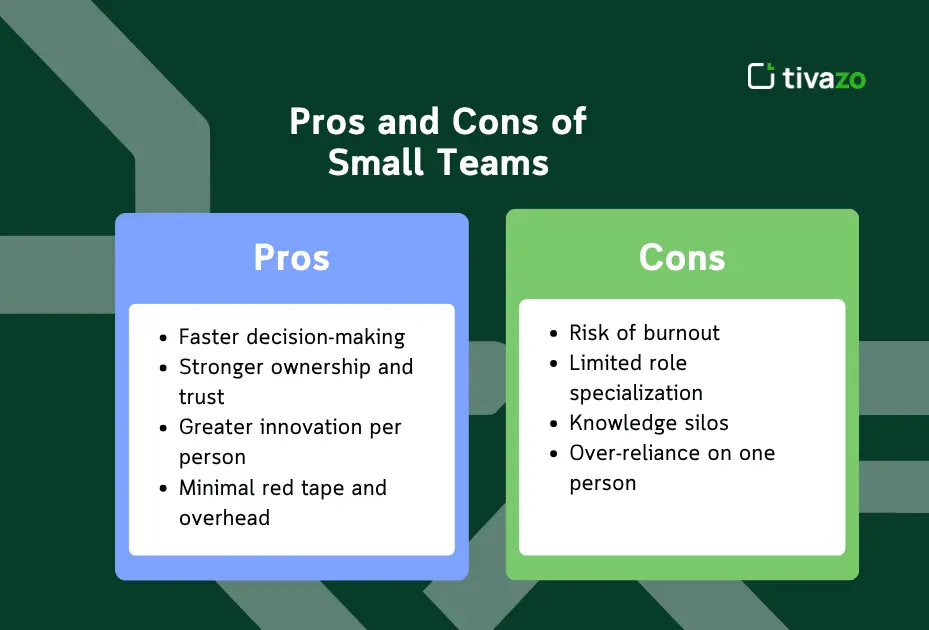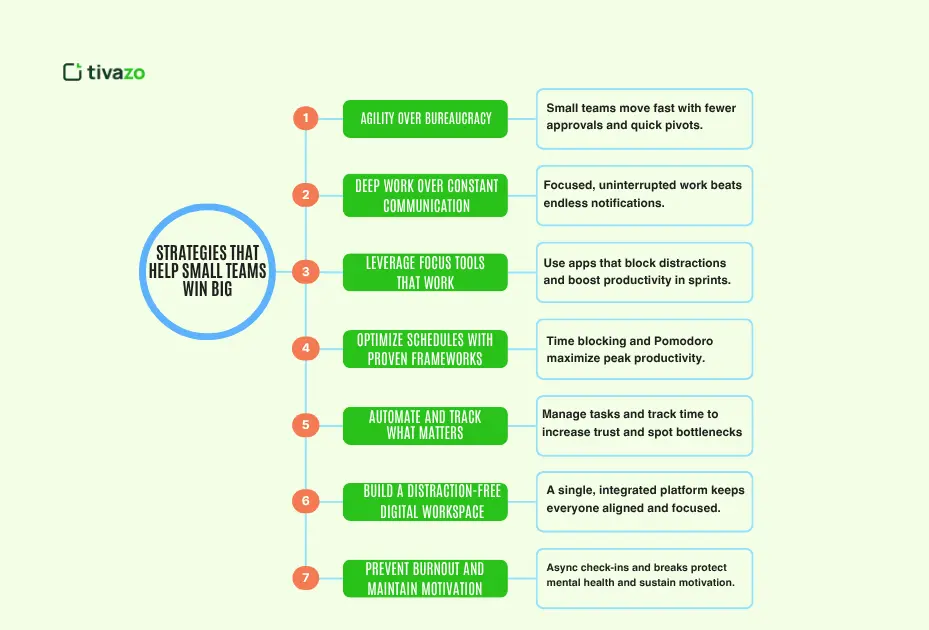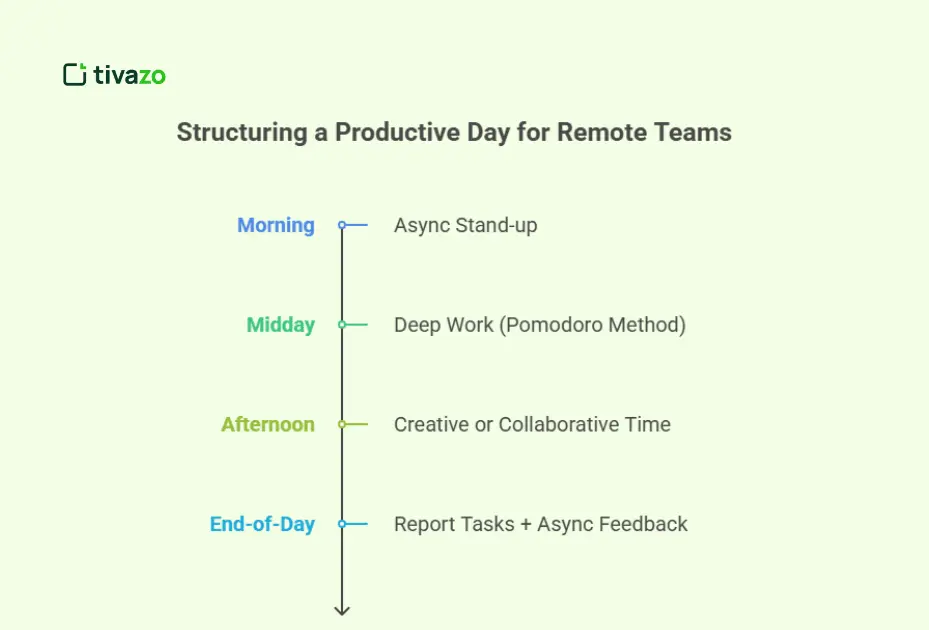In the fast-paced, remote-first world of today, smaller teams have an unanticipated advantage. Big companies win on scale, small teams win with speed, trust, and focus. If you’re like me and you’re curious how small teams can win big, this post features 7 proven strategies and tools that empower small groups to outperform larger competitors. If you’re the founder of a startup, lead a remote team, or are a bootstrapping solopreneur growing your business, this eBook is a roadmap for you to win smarter.
Key Highlights:
- What Is a Small Team
- Pros and Cons of Small Teams
- 7 Proven Strategies That Help Small Teams Win Big
- Top Tools That Supercharge Small Team Output
- Daily Routine Template for Remote or Hybrid Teams for a Productivity Day
What Is a Small Team?
That small team is usually 3–10 people who are trying to figure everything out together. They’re agile and efficient and can adapt on a dime, perfect for startups, project squads, and remote pods.
How Many People Make a Small Team?
A ‘small team’ varies widely, and typically this number is somewhere between 3 and 10 people, depending on the requirements and ambitions of the organization. At the lower end, between 3 and 5 members typically act as core founder teams or micro teams for certain activities. Creators of six to eight are a little less commonly found, and they often run as agile pods, where there are cross-functional roles, such as product development and marketing, which allow a project to be built and brought to market quickly.
After about nine to 10 members, a team often reaches a critical mass where it can function as a full team; they span several departments, but still have the close collaboration and speed that are characteristic of small teams.
Pros and Cons of Small Teams

Pros:
Small groups have certain advantages that large groups typically find difficult to replicate. The small size encourages intimate discussion, rapid decisions, and high levels of ownership among its constituents. Closer to the ground. If there are fewer levels of management, small teams move with speed, and that speed allows them to innovate with fewer fetters and develop an idea for implementation with very little bureaucracy.
- Faster decision-making
- Stronger ownership and trust
- Greater innovation per person
- Minimal red tape and overhead
Cons:
Small teams are wonderful too, but have their drawbacks. Smaller teams can mean a greater workload, which can lead to feelings of burnout. When team members don’t specialize, they are likely to cover multiple bases, forming knowledge silos and depending on individual performance.
- Risk of burnout
- Limited role specialization
- Knowledge silos
- Over-reliance on one person
Small Team Synonyms
In small squads, there are often other names that reflect on the focus and their flexibility. Agile squad, micro-team, or lean team are some of the terms they use to describe their speed and efficiency. A pod and a task force are small groups of people who work together closely and focus on goals.
The Power of Being Small: Advantages Over Large Teams
Small is better than large in focus, co-operation, and execution. Good Ideas Come from everywhere. Where large teams are plagued by slow approvals and miscommunication, small teams iterate quickly and stay aligned.
- Small teams are great at focus, because there are fewer members to distract and the priorities are clearer.
- With close communication and shared ownership, they drive better collaboration.
- Small teams execute decisions quickly, avoiding the slow approval processes common in large teams.
- Lack of communication and information are issues, typically, big team problems that small teams tend to avoid.
- Small groups can move quickly and turn on a dime.
- With less hierarchy, small teams stay tightly focused on results, which is the key to increasing productivity and innovation.
- Their lean existence cuts through red tape, and there is less hallway between napkin and shippable code.
7 Proven Strategies That Help Small Teams Win Big
The 7 Proven Strategies That Help Small Teams Win Big are:

1. Agility Over Bureaucracy
Smaller teams are not subject to the slow, convoluted procedures that often infect larger groups. With fewer decision makers, ideas are moving fast out of the chat room and into play, and that means less time waiting on approvals and more time spent building. Agile teams can also pivot quickly in response to changing priorities or customer demand, which is a massive competitive advantage.”
2. Deep Work Over Constant Communication
Rather than swimming in infinite notification chat cycles, small groups of people have deep work-focused, uninterrupted sessions where they get their actual work done. Team members unfurl updates without losing focus, using things like asynchronous communication tools Twist or Loom. It eliminates distraction, both in person and on screen, and enables everyone to do better work.
3. Leverage Focus Tools That Work
Apps for focus: To do deep work, small teams rely on apps that help them focus. This particular kind of app is a distraction blocker: It’s designed to temporarily block distracting websites or apps that are getting in the way of your productivity. Apps like Pomofocus or Forest are focus timers that help you work in short sprints with breaks in between, so you can stay productive without burning out. These techniques help create sustainable work behaviors.
4. Optimize Schedules With Proven Frameworks
Effective scheduling is key. Smaller teams often apply time blocking, chunks of the day dedicated to different tasks, and the Pomodoro technique, in which work is broken down into 25-minute focused intervals interspersed with short breaks. “Scheduling yourself around your peak productivity hours and not the ones the office dictates will allow you to get the most work done and keep your energy levels up.
5. Automate and Track What Matters
Tracking progress without micromanaging leads to trust. Apps such as ClickUp can help manage tasks and workflows, and Tivazo tracks time spent on projects. It significantly cuts manual effort and makes it easy to see where the projects are in the process, so teams can spot bottlenecks and celebrate where they’re making progress.
6. Build a Distraction-Free Digital Workspace
Lean digital working spaces excel in small team scenarios. And by using platforms like Notion or Trello as your single source of truth, you can reduce how often your team jumps in and out of apps, and you help keep everyone in a state of aligned consistency. Communication apps like Slack are integrated to make these updates easily discoverable and actionable, reducing cognitive load and keeping distractions to a minimum.
7. Prevent Burnout and Maintain Motivation
Consistent success relies on mental fitness. Small teams head off burnout by promoting async check-ins (ie, meeting overload), remote work hours, or even regular scheduled breaks or digital detoxes. The promotion of mental health is essential to the promotion of high motivation, creativity, and productivity over the longer term.
How Is Tivazo Better for Small Teams?
Small teams need simple, strong tools that won’t overwhelm them, yet will make them more productive. Tivazo is an integrated workplace, developed specifically for small, nimble teams, where task management, real-time collaboration, and “distraction-free” apps converge.
- All-in-one workspace: Toss away the clumsy tools, and you can chat, share, part files, and much more inside the slab.
- User-friendly interface: Intuitive to users who understand e-records; basic computer training is all that is required for users to use this tool.
- Focus features: Use the built-in focus timer and distraction blockers to keep your team in the zone.
- Async/real-time collaboration: A perfect blend of hybrid and remote work.
- Affordable pricing: Perfect for startups and small businesses with budget constraints.
After all, you have nothing to lose by trying Tivazo today when it comes to becoming more efficient, getting your team to focus, and scoring a bigger victory.
Top Tools That Supercharge Small Team Output
| Tool | Use Case | Best For |
| Notion | Docs, tasks, knowledge | All-in-one hub |
| Trello | Kanban task boards | Visual planning |
| ClickUp | Tasks + docs + tracking | Fast-moving teams |
| Clockify | Time & work tracking | Accountability |
| Slack | Async messaging | Daily updates |
The best productivity tools for remote teams offer integrations, speed, and flexibility without complexity.
How Can Small Teams Improve Focus in a Distracted World?
Disruptions can be counter-productive, a huge negative, especially when you are on a very small team where every person matters. Focus timer apps like Pomofocus or Forest can help you fragment work into focused bursts interspersed with breaks, increasing your concentration. Distraction blockers such as Cold Turkey help block social media intrusions during work hours. Chats (especially group channels, like Slack, etc.)
Many teams get fragmented and hindered by constant interruptions because people use “chat” in place of asynchronous communication (if they must use chatting). Using task batching to group similar tasks also minimizes mental switching. A culture that values distraction-free deep work makes it much easier for small groups to focus and deliver faster, better results.
Why Motivation Is Crucial for Small Remote Teams
Team members in small, remote teams are motivated more than that, because each of them counts towards the teamwork. Frequent acknowledgment and feedback, even if asynchronous, work wonders for morale. Collaborators are enabled and empowered because of flexible working hours and autonomy, and thus they are happier.
Virtual social events are a way to fend off isolation and increase connection. Purpose comes from clear goals that connect what employees do as individuals to the team’s overall success. With these simple beats, you can help your small teams to stay motivated, prevent burnout, and keep winning big.
Daily Routine Template for Remote or Hybrid Teams for a Productivity Day
A consistent daily routine keeps remote and hybrid teams aligned and productive, even when working apart. Here’s a simple template to structure your team’s day:

- Morning: Async Stand-up
Begin with a brief, asynchronous check-in that everyone logs ahead of time, including their goals and priorities. This eliminates those long meetings while staying on the same page with the rest of the team. - Midday: Deep Work (Pomodoro Method)
Focus for a couple of hours in the middle of the day with the Pomodoro technique (25 minutes of work + 5-minute break). This technique increases productivity and saves energy. - Afternoon: Creative or Collaborative Time
Keep afternoons for brainstorming meetings, team meetings, or creative work that benefits from teamwork. This ratio enables work both as individuals and in groups. - End-of-Day: Report Tasks + Async Feedback
Wrap things up by asynchronously reporting progress and offering feedback. This holds everyone accountable, and primes the team for the next day without having to do live meetings.
Time Management Tips for Small Teams Working From Home
Effective time management when working from home begins with blocking deep slots in the calendar, enabling team members to commit to pure focus, free from distractions. Banish micromanagement with the confidence that asynchronous updates hold everyone accountable while respecting their workflow and autonomy.
Statinggift.com or using a planning app like Sunsama, or a to-do list app like Todoist, can keep tasks and progress organized. And sometimes a small change, like imposing a blocked morning sprint, can produce a sizable enhancement in your team’s collective productivity.
How to Track Work Progress and Team Metrics
It’s easier to keep track of progress in small teams when you have the right tools. Leverage ClickUp dashboards to see tasks, status, and team load all in one place. They use Tivazo to track time and compare the actual time spent to the estimate. Weekly, asynchronous recaps around KPIs keep the team in synch without interrupting the flow of work.
By consolidating information in your digital workspace apps, you make it easier for colleagues to stop chasing updates, and you encourage more transparency.
Conclusion: How Small Teams Win Big (And You Can Too)
Small teams flourish when they implement the right mindset, tools , and workflow. Little planning and little time, and small teams can move faster and produce better than the larger groups because focusing deeply, being flexible, and using efficient productivity systems will never outshine going faster alone. So, now that you’ve learned how small teams can land big wins, the next step is to take action: select one productivity tool and one proven strategy mentioned in this guide, and apply both from today.
Success at work has nothing to do with how many people you have; it’s about having a smart, focused team. If you play your cards right, a small team can accomplish big things.
FAQs
What is a small team size?
Small teams typically consist of 3 to 10 members, enough for diverse skills but small enough for quick decisions.
How many is a small team?
Most small teams have between 3 and 10 people, depending on the project and organization.
What is a small group or team?
A small group or team is a compact, focused set of individuals who collaborate closely to achieve common objectives.




